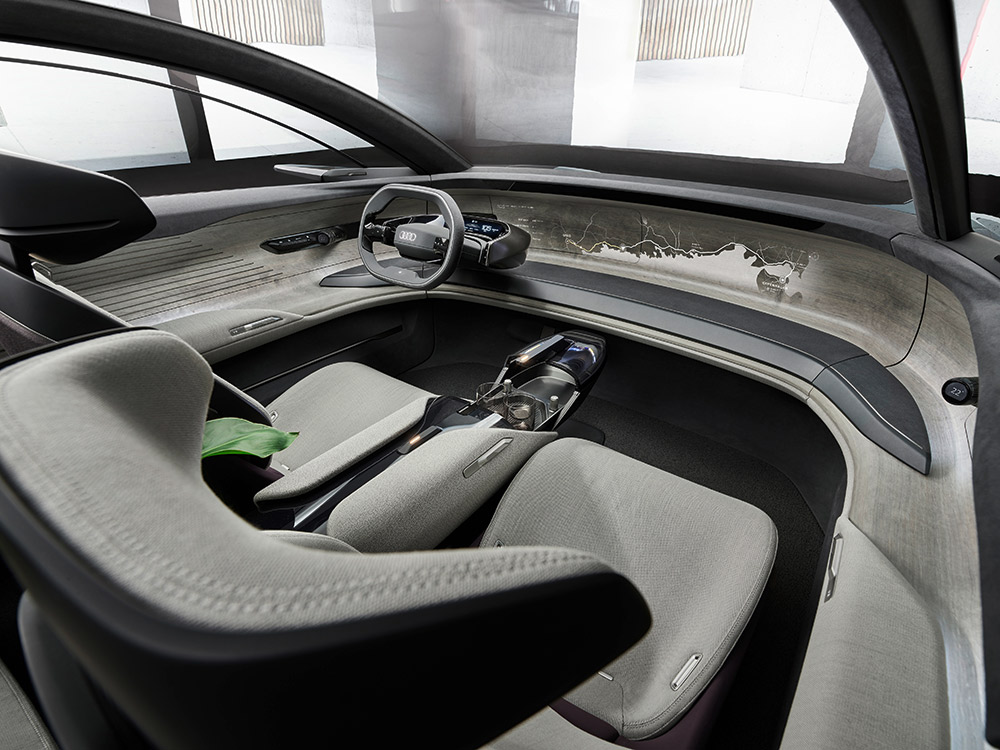你有没有想过,坐在豪华私人飞机一般的舒适环境中,闭上眼睛,身前的汽车方向盘自动转动着,是什么样的感觉?
德国汽车制造商奥迪正在试图将竞争对手特斯拉和梅赛德斯-奔驰从高端汽车行业的尖顶上赶下来。9月2日,奥迪发布了“Grandsphere”概念车,回答了这一问题。
奥迪发布了登月系列电动汽车Artemis的外观。这一大众集团旗下的最新技术力作,将于2025年正式面世。
“这是一辆主要由内而外构思的汽车,但外观却很是可爱。”奥迪的首席执行官马库斯·杜斯曼在一次新闻发布会上告诉记者,“Grandsphere的概念很好地指明了Artemis系列车型生产版本的发展方向。”
奥迪表示,这款长5.35米、宽2米的概念车甚至比奥迪A8旗舰车的加长版本还要大,会给司机和乘客一种在云端乘坐头等舱的感觉。

Artemis将是奥迪首次进入自动驾驶汽车领域。这款车最终将为司机提供一种奢侈的体验——如果他们愿意的话,可以关闭自己的思绪,进入梦乡。
这种边开车边睡觉的自由,只有在业内被称为“Level 4”的全自动驾驶模式下才能够实现。这也是奥迪在2025年至2030年的努力方向。
比如,当司机想要把控制权交给汽车时,方向盘会消失在汽车的前面板中,但只需要一个手势就又可以把它“呼唤”回来。
汽车内饰中的木材、羊毛织物和金属,给人一种身处自然的感觉;而黑色的触屏显示器被集成到汽车中的图像所取代,给人一种电影般的体验。奥迪表示,车内没有任何皮革制品,“符合人们对奢侈品的先进理解”。
这款巨大的23英寸车轮可以支持120千瓦时电池的底盘的安装,一次充电能够让汽车行驶超过750公里。
这一概念车还有一个特点,即车门可以向相反的方向打开,就像四轮马车一样。这一设计消除了中间支柱(原用以为碰撞情形提供结构刚性),从而给车内带来了更大的空间感。而这一备受喜爱的设计元素,几乎从未投入生产过。

这并不是奥迪第一次承诺自动驾驶功能。2017年,奥迪推出了目前的A8车型,并推出了世界上首款“可移开视线”的“Level 3”级别的高自动化驾驶技术。在高速公路低速行驶等情况下,司机不再需要监督车辆,倘若发生事故,责任将直接转移到汽车制造商。
这一功能在欧洲过于先进,因此未能得到监管程序的批准,这项功能也就一直处于休眠状态。直到三年后,监管机构坚持要求奥迪在尾部安装摄像头,以检测从后面靠近的紧急车辆,奥迪才最终放弃了自己的野心。
相比之下,特斯拉采取的方法不同,倾向于最大限度地增加车辆激活其完全自动驾驶(Full Self-Driving)系统能力的情况。尽管美国正在进行联邦安全调查,目前,特斯拉正在复杂的城市环境中测试完全自动驾驶系统,让客户作为测试驾驶员。由于该公司的首席执行官埃隆·马斯克拒绝承担责任,车主必须承担事故中造成的任何损失,导致其必须随时都要监督车辆。这意味着,完全自动驾驶系统只是一个二级辅助系统,并不能提供真正的自动驾驶功能。
在法律可行性方面存在的风险和不确定性,也是奥迪不希望在2025年推出这款车时提供“Level 4”自动驾驶功能的原因之一。(财富中文网)
编译:杨二一
你有没有想过,坐在豪华私人飞机一般的舒适环境中,闭上眼睛,身前的汽车方向盘自动转动着,是什么样的感觉?
德国汽车制造商奥迪正在试图将竞争对手特斯拉和梅赛德斯-奔驰从高端汽车行业的尖顶上赶下来。9月2日,奥迪发布了“Grandsphere”概念车,回答了这一问题。
奥迪发布了登月系列电动汽车Artemis的外观。这一大众集团旗下的最新技术力作,将于2025年正式面世。
“这是一辆主要由内而外构思的汽车,但外观却很是可爱。”奥迪的首席执行官马库斯·杜斯曼在一次新闻发布会上告诉记者,“Grandsphere的概念很好地指明了Artemis系列车型生产版本的发展方向。”
奥迪表示,这款长5.35米、宽2米的概念车甚至比奥迪A8旗舰车的加长版本还要大,会给司机和乘客一种在云端乘坐头等舱的感觉。
Artemis将是奥迪首次进入自动驾驶汽车领域。这款车最终将为司机提供一种奢侈的体验——如果他们愿意的话,可以关闭自己的思绪,进入梦乡。
这种边开车边睡觉的自由,只有在业内被称为“Level 4”的全自动驾驶模式下才能够实现。这也是奥迪在2025年至2030年的努力方向。
比如,当司机想要把控制权交给汽车时,方向盘会消失在汽车的前面板中,但只需要一个手势就又可以把它“呼唤”回来。
汽车内饰中的木材、羊毛织物和金属,给人一种身处自然的感觉;而黑色的触屏显示器被集成到汽车中的图像所取代,给人一种电影般的体验。奥迪表示,车内没有任何皮革制品,“符合人们对奢侈品的先进理解”。
这款巨大的23英寸车轮可以支持120千瓦时电池的底盘的安装,一次充电能够让汽车行驶超过750公里。
这一概念车还有一个特点,即车门可以向相反的方向打开,就像四轮马车一样。这一设计消除了中间支柱(原用以为碰撞情形提供结构刚性),从而给车内带来了更大的空间感。而这一备受喜爱的设计元素,几乎从未投入生产过。
这并不是奥迪第一次承诺自动驾驶功能。2017年,奥迪推出了目前的A8车型,并推出了世界上首款“可移开视线”的“Level 3”级别的高自动化驾驶技术。在高速公路低速行驶等情况下,司机不再需要监督车辆,倘若发生事故,责任将直接转移到汽车制造商。
这一功能在欧洲过于先进,因此未能得到监管程序的批准,这项功能也就一直处于休眠状态。直到三年后,监管机构坚持要求奥迪在尾部安装摄像头,以检测从后面靠近的紧急车辆,奥迪才最终放弃了自己的野心。
相比之下,特斯拉采取的方法不同,倾向于最大限度地增加车辆激活其完全自动驾驶(Full Self-Driving)系统能力的情况。尽管美国正在进行联邦安全调查,目前,特斯拉正在复杂的城市环境中测试完全自动驾驶系统,让客户作为测试驾驶员。由于该公司的首席执行官埃隆·马斯克拒绝承担责任,车主必须承担事故中造成的任何损失,导致其必须随时都要监督车辆。这意味着,完全自动驾驶系统只是一个二级辅助系统,并不能提供真正的自动驾驶功能。
在法律可行性方面存在的风险和不确定性,也是奥迪不希望在2025年推出这款车时提供“Level 4”自动驾驶功能的原因之一。(财富中文网)
编译:杨二一
Ever wondered what it might be like to sit back and get some shut eye in the relaxing ambience of a luxury private jet…only while sitting behind the wheel of a moving vehicle?
In its quest to topple rivals Tesla and Mercedes-Benz from the top of the premium car industry, German automaker Audi attempted to answer that question on September 2 with its "Grandsphere" concept.
It offers a glimpse of what its moonshot electric vehicle, previously known as “Artemis,” will look like when the Volkswagen Group brand’s technological tour-de-force is scheduled to arrive in 2025.
"It's a car that was predominantly conceived from the interior outward, and yet has a lovely exterior form," CEO Markus Duesmann told reporters in a briefing. "The Grandsphere gives a very good indication of the direction the series production version of the Artemis will take."
The 5.35-meter (17.6 feet) long and 2-meter wide concept, larger than even the stretch version of its A8 flagship sedan, should offer the feeling of traveling first class in the clouds, the company said.
Artemis will be the carmaker’s first entry into the autonomous vehicle space, eventually offering drivers the luxury of switching their minds off and drifting off to sleep if they so choose.
This kind of freedom to sleep while at the wheel only comes with fully automated driving known within the industry as “Level 4,” which Audi is developing for the second half of the decade.
When the driver wants to transfer control over to the vehicle, for example, the steering wheel disappears into the vehicle’s front panel, while a gesture of the hand is all that is needed to coax it back out.
Wood, wool fabrics, and metal give the feeling of a natural environment while black touchscreen displays are replaced by images integrated into the car to give a cinema-like experience. No leather can be found anywhere in the vehicle "in keeping with a progressive understanding of luxury," according to the company.
The massive 23-inch wheels support a chassis equipped with a 120 kilowatt hour battery capable of powering the vehicle across a distance of over 750 kilometers (466 miles) on one charge.
The concept features doors that open up in opposite directions like a coach wagon. This beloved design element, which rarely if ever makes it to production, gives a greater feeling of interior roominess by doing away with the middle pillar that provides structural rigidity to the vehicle in the event of a crash.
This isn’t the first time Audi has promised self-driving features. In 2017, it launched the current A8 with the world’s first “eyes-off” Level 3 highly-automated driving. In certain circumstances, such as highway driving at slow speeds, the driver was no longer required to supervise the vehicle and liability in the event of a crash transfers to the manufacturer.
It was so advanced for Europe that there was no regulatory process to approve it, so the feature remained dormant until three years later, when Audi buried its ambitions definitively after regulators insisted it needed a camera in the rear to detect emergency vehicles approaching from behind.
Tesla by comparison has taken a different approach, preferring to maximize the number of cases when a vehicle can activate its Full Self-Driving (FSD) systems capabilities. Currently, it's testing FSD in complex urban environments, using its customers as test drivers, despite a federal safety probe in the U.S. Since CEO Elon Musk refuses to accept liability, the cars' owners pick up the tab for any damages incurred in an accident and must therefor supervise the vehicle at all times. That means FSD is only a Level 2 assistance system, rather than offering true automated driving.
Risks and uncertainties regarding what will legally be possible is one reason why Audi does not expect to offer Level 4 self-driving capabilities when the vehicle is due to launch in 2025.






